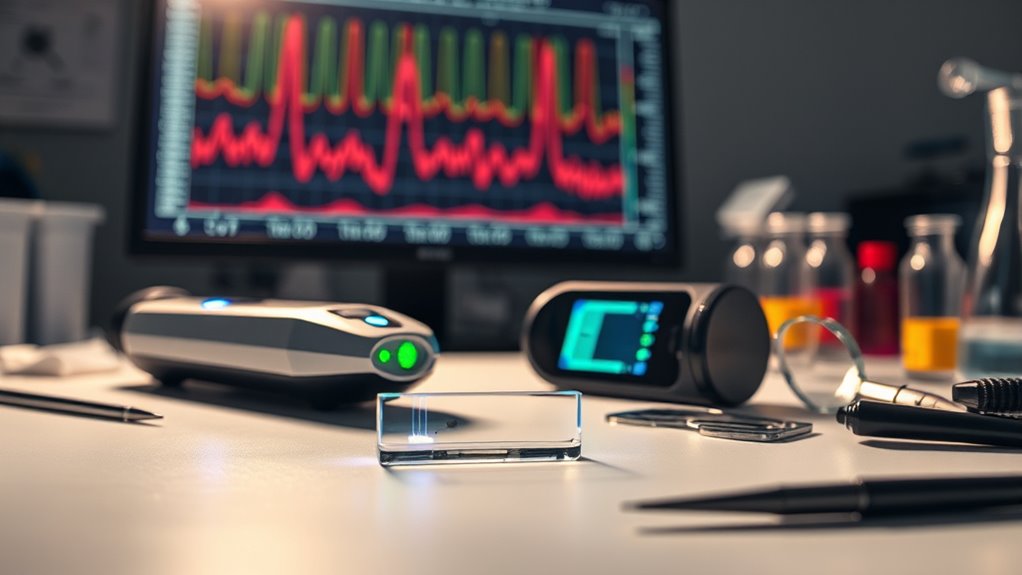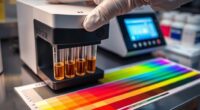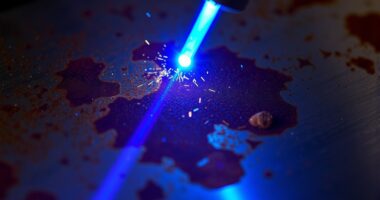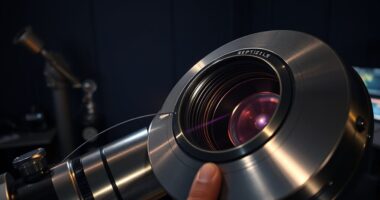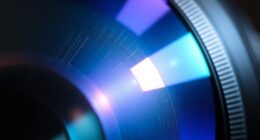Spectroscopy in forensic science helps you analyze evidence quickly and accurately while minimizing damage. It allows you to identify substances like biological fluids, drugs, paint, or fibers with high sensitivity. Techniques such as IR, Raman, XRF, and LIBS enable you to trace residues, distinguish DNA, and match materials to specific sources or suspects. If you’re curious how these methods work together to solve crimes efficiently, there’s more to discover behind the scenes.
Key Takeaways
- Spectroscopy enables rapid, minimally destructive analysis of biological, chemical, and trace evidence in forensic investigations.
- Techniques like IR and Raman spectroscopy differentiate human from non-human DNA without damaging samples.
- XRF and LIBS identify firearm residues and ammunition components, linking suspects to crime scenes.
- Spectroscopic methods detect illicit drugs, fibers, paint chips, and counterfeit materials with high sensitivity.
- Overall, spectroscopy provides accurate, quick results that preserve evidence integrity, improving forensic case efficiency.

Spectroscopy has become an essential tool in forensic science, enabling investigators to analyze evidence with high precision and minimal destruction. When examining crime scene evidence, spectroscopy allows you to identify chemical compositions quickly and accurately, which is crucial for solving cases efficiently. For example, in DNA analysis, spectroscopic techniques like infrared (IR) spectroscopy and Raman spectroscopy help you detect and characterize biological samples without damaging the fragile evidence. These methods can differentiate between human and non-human DNA, confirm the presence of biological fluids, and even provide insights into the genetic material’s purity. This non-destructive approach means you can preserve vital evidence for further testing or court presentation, while gaining rapid, reliable results.
In ballistics examination, spectroscopy plays a pivotal role in analyzing firearm residues and ammunition components. When a bullet is recovered from a crime scene, you can use techniques such as X-ray fluorescence (XRF) and laser-induced breakdown spectroscopy (LIBS) to determine the elemental composition of gunshot residues or cartridge casings. These methods help you match residues to specific firearms or ammunition brands, strengthening your case. Spectroscopy enables you to identify traces of lead, barium, and antimony, which are typical components of gunshot residues, with remarkable accuracy. By doing so, you can establish a link between a suspect, a weapon, and a crime scene, all while avoiding the contamination risks associated with traditional destructive testing methods.
Furthermore, spectroscopy’s versatility allows you to analyze a wide range of evidence types beyond biological and ballistic samples. For instance, you can identify illicit drugs, trace evidence like fibers or paint chips, and even counterfeit materials. Its rapid analysis time means you can process multiple samples efficiently, providing timely information to investigators. The high sensitivity of spectroscopic techniques allows you to detect minute quantities of substances, which is often critical in forensic investigations where evidence is limited.
Frequently Asked Questions
How Accurate Is Spectroscopy Compared to Other Forensic Analysis Methods?
Spectroscopy offers high spectroscopic precision and excellent analytical consistency, making it quite accurate compared to other forensic methods. You can rely on it to identify substances with confidence, especially when combined with other techniques. While no method is perfect, spectroscopy‘s ability to provide detailed molecular information often surpasses traditional analysis in accuracy. You’ll find it a dependable tool for forensic investigations, especially in complex cases requiring precise substance identification.
Can Spectroscopy Detect Fake or Adulterated Substances?
Yes, spectroscopy can detect fake or adulterated substances effectively. You can use it for fake detection by analyzing the molecular composition and identifying impurities or unusual patterns that suggest adulteration. Spectroscopy’s high sensitivity helps you distinguish genuine products from counterfeits or contaminated samples. This makes it a valuable tool in forensic science for ensuring the integrity of substances and preventing the distribution of adulterated or fake materials.
What Are the Limitations of Spectroscopy in Forensic Investigations?
Did you know that over 60% of forensic errors involve spectral overlap? Spectroscopy has limitations, like sample contamination, which can skew results, and spectral overlap, making it difficult to distinguish substances accurately. You might face challenges identifying complex mixtures or degraded samples. These issues can lead to misinterpretations, so it’s vital to combine spectroscopy with other techniques to improve reliability in forensic investigations.
How Expensive Is Spectroscopy Equipment for Forensic Labs?
Spectroscopy equipment for forensic labs can be quite costly, often ranging from tens of thousands to over a hundred thousand dollars depending on the technology. You should consider the cost comparison for initial purchase and ongoing expenses like equipment maintenance, which can add up over time. While the investment is significant, advanced spectroscopy tools improve accuracy and efficiency, helping you get reliable results faster.
Is Specialized Training Required to Interpret Spectroscopic Data?
You’ll need specialized training to interpret spectroscopic data effectively. Studies show that even experienced scientists improve accuracy with targeted training, which enhances their interpretative skills. Training requirements vary depending on the complexity of the technique, but generally, a combination of coursework and hands-on experience is crucial. Without proper training, you risk misinterpreting essential forensic evidence, so investing in education guarantees you’re confident and precise when analyzing spectroscopic results.
Conclusion
In forensic science, spectroscopy proves to be a powerful tool, revealing hidden details that can make or break an investigation. You now see how this technique helps uncover evidence with precision and confidence. Remember, “The devil is in the details,” and spectroscopy guarantees you don’t overlook any. By harnessing this technology, you can bring clarity to complex cases and seek justice with greater certainty. Embrace it, and let science be your guiding light.
